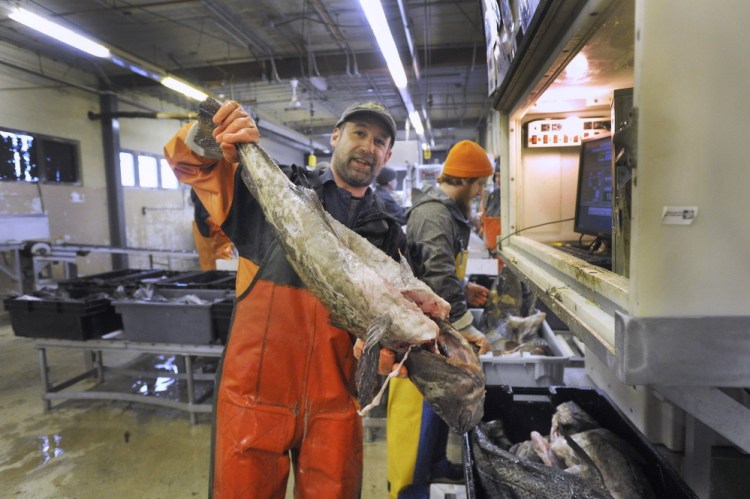Federal regulators working to save plummeting cod stocks in the Gulf of Maine may decide this week to ban lobster fishing in parts of the ocean where cod spawn – an unprecedented step that raises jurisdictional questions over who calls the shots in managing commercial fisheries.
The New England Fishery Management Council is expected to vote on the lobster-gear proposal Tuesday afternoon or Wednesday when it meets in Newport, Rhode Island, to set rules for the 2015 groundfishing season, which begins in May.
The regulators are considering several steps – including closing some areas to all fishing during certain months – to protect cod stocks in coastal areas of the Gulf of Maine, where the cod population is at 3 to 4 percent of a level considered sustainable, its lowest since scientists began tracking the species 40 years ago.
Regulators are now examining whether the region’s lobster fishery is partly at fault. In 2008, the year for which the most recent data are available, an estimated 177,000 cod were captured in lobster traps in Maine state waters. If each fish weighed a pound, which would be small for that species, it would total 80 metric tons. A scientific committee last week recommended that the council set a catch limit for Gulf of Maine cod of 386 metric tons.
Patrice McCarron, executive director of the Maine Lobstermen’s Association, said the proposal to ban lobster gear in the protected waters raises a “grave concern” among her members.
Her group is critical of the science used to characterize the level of cod bycatch by the lobster fishery and the lack of peer-reviewed research on the impact of the bycatch on the recovery of the cod population.
Also opposing the measure is Patrick Keliher, commissioner of the Maine Department of Marine Resources, who said the council should be wary of making any decisions based on the 2008 survey.
Keliher, who described the analysis as a “very rough” estimate, believes it overestimates the bycatch of cod by Maine lobstermen. In an email, he said his department will “strongly urge” the council to support more research before taking any management action.
“This rudimentary analysis should not be the basis for management decisions,” he said of the 2008 estimate.
Last year, the Maine lobster catch was valued at $364 million, which represents 69 percent of the state’s commercial fishing revenue.
OTHER RESTRICTIONS ON COD FISHING
The New England Fishery Management Council’s meeting this week comes in the wake of last week’s decision by the National Oceanic and Atmospheric Administration to impose emergency measures that would close parts of the Gulf of Maine to commercial and recreational cod fishing.
The six-month emergency restrictions, which went into effect Thursday, include a 200-pound limit on how much a fishing vessel can catch during a single trip – designed to reduce the number of cod caught by boats fishing for other species such as haddock – and “rolling closures” on coastal fishing grounds where cod are most abundant and where they spawn. Those areas are generally on fishing grounds between Massachusetts Bay and southern Maine.
The New England Fishery Management Council’s Groundfish Committee last week voted to recommend that the council prohibit lobster gear in those areas.
The lobster-gear ban would only apply to fishing in federal waters, which begin 3 miles off the coast. The closure areas, which would change every month, are approximately 60 square miles to 100 square miles and located near state waters. The council this week is expected to vote to impose those rolling closures through the 2015 fishing year.
The proposal would mostly affect federally licensed lobstermen in eastern Massachusetts, New Hampshire and southern Maine. In Maine, 1,224 lobstermen hold federal licenses. The federal government does not mandate that lobstermen report harvest data, so federal fisheries scientists will have to work closely with state agencies and state lobstering groups to get an idea of the proposal’s impact on lobstermen, said Peter Burns, a fishery policy analyst at the National Marine Fisheries Service.
The council’s proposal could also set off a jurisdictional battle.
Groundfish and lobsters are managed by different agencies. The New England Fishery Management Council has sole jurisdiction over groundfish, which are found in federal waters – between 3 miles and 200 miles offshore.
Lobsters, though, are found in both state and federal waters. In state waters, they are managed by the states. In federal waters, lobsters are managed cooperatively by states and the federal government through the Atlantic States Marine Fisheries Commission and its Lobster Management Board.
While the New England Fishery Management Council has no authority to manage the lobster fishery, it can put limits on lobster gear to protect groundfish stocks, Burns said.
Keliher said the council should not take any action without consulting the Atlantic States Marine Fisheries Commission and the Lobster Management Board.
McCarron, of the Maine Lobstermen’s Association, echoed Keliher’s concerns and said that regulators also need to get broad input from lobster industry stakeholders.
Send questions/comments to the editors.



Comments are no longer available on this story